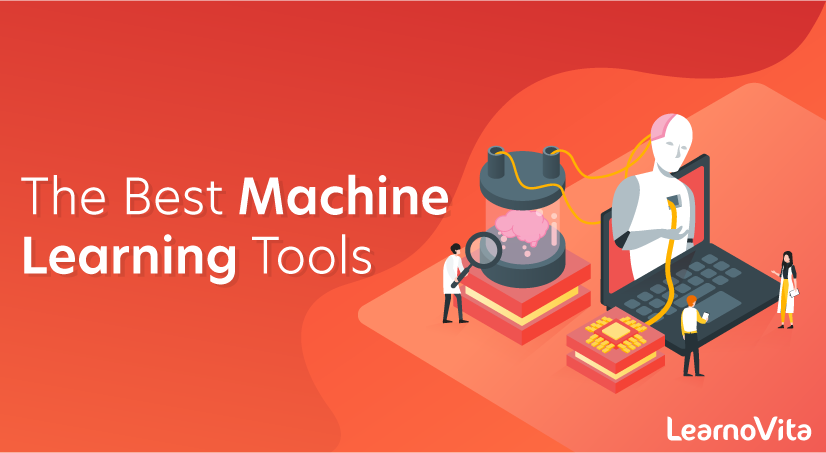
The Best Machine Learning Tools
Last updated on 14th Oct 2020, Artciles, Blog
What are Machine Learning Tools?
Machine learning tools are algorithmic applications of artificial intelligence that give systems the ability to learn and improve without ample human input; similar concepts are data mining and predictive modeling. They allow software to become more accurate in predicting outcomes without being explicitly programmed. The idea is that a model or algorithm is used to get data from the world, and that data is fed back into the model so that it improves over time. It’s called machine learning because the model “learns” as it is fed more and more data.
What is Machine Learning?
With the help of machine learning systems, we can examine data, learn from that data and make decisions. Machine learning involves algorithms and Machine learning library is a bundle of algorithms.
Machine Learning Real Examples
Given below are some real examples of ML:
Example1:
If you have used Netflix, then you must know that it recommends you some movies or shows for watching based on what you have watched earlier. Machine Learning is used for this recommendation and to select the data which matches your choice. It uses the earlier data.
Example2:
The second example would be Facebook.
When you upload a photo on Facebook, it can recognize a person in that photo and suggest you, mutual friends. ML is used for these predictions. It uses data like your friend-list, photos available etc. and it makes predictions based on that.
Subscribe For Free Demo
Error: Contact form not found.
Example3:
The third example is Software, which shows how you will look when you get older. This image processing also uses machine learning.
All these are some examples, that help us to understand, how machine learning is used. ML is similar to AI up to some extent, however, there is a difference between the two. It is related to data mining.
How does Machine Learning Help us?
It helps through powerful processing.
With the help of machine learning, systems make better decisions, at a high speed and most of the times they are accurate. Using this technique is inexpensive and it can analyze large and complex data sets.
Types of Machine Learning
Enlisted below are the various types:
- Supervised
- Unsupervised
- Reinforcement
Let’s see each type in detail along with an example.
1)Supervised Machine Learning
Past data is used to make predictions in supervised machine learning.
Example
of supervised machine learning is the spam filtering of emails. We all use Gmail, Yahoo, or Outlook. Machine learning algorithms are used for deciding which email is spam and which is not.
Based on the previous data like received emails, data that we use etc., the system makes predictions about an email as for whether it is a spam or not. These predictions may not be perfect, but they are accurate most of the times.
Classification and Regression are the ML algorithms that come under Supervised ML.
2)Unsupervised Machine Learning
Unsupervised machine learning finds hidden patterns.
Earlier we saw the example of Facebook (Example 2). This is an example of unsupervised machine learning. Clustering and Association algorithms come under this type of machine learning.
3)Reinforcement Machine Learning
Reinforcement machine learning is used for improving or increasing efficiency.
Let’s explore some examples of the above-mentioned algorithms.
- Classification: Spam filtering of emails.
- Regression: These algorithms also learn from the previous data like classification algorithms but it gives us the value as an output. Example: Weather forecast – as how much rain will be there?
- Clustering: These algorithms use data and give output in the form of clusters of data. Example: Deciding the prices of house/land in a particular area (geographical location).
- Association: When you buy products from shopping sites, the system recommends another set of products. Association algorithms are used for this recommendation
This is all about machine learning. Now let’s take a look at the top machine learning software.
=>Contact us to suggest a listing here.10+Most Popular Machine Learning Software Tools
There are several Machine Learning Software that is available in the market. Enlisted below are the most popular ones among them.
Comparison Chart
| Platform | Cost | Written in language | Algorithms or Features | |
|---|---|---|---|---|
| Scikit Learn | Linux, Mac OS, Windows | Free. | Python, Cython, C, C++ | ClassificationRegressionClusteringPreprocessingModel SelectionDimensionality reduction. |
| PyTorch | Linux, Mac OS,Windows | Free | Python, C++,CUDA | Autograd ModuleOptim Modulenn Module |
| TensorFlow | Linux, Mac OS,Windows | Free | Python, C++,CUDA | Provides a library for dataflow programming. |
| Weka | Linux, Mac OS,Windows | Free | Java | Data preparationClassificationRegressionClusteringVisualizationAssociation rules mining |
| KNIME | Linux, Mac OS,Windows | Free | Java | Can work with large data volume.Supports text mining & image mining through plugins |
| Colab | Cloud Service | Free | – | Supports libraries of PyTorch, Keras, TensorFlow, and OpenCV |
| Apache Mahout | Cross-platform | Free | JavaScala | PreprocessorsRegressionClusteringRecommendersDistributed Linear Algebra. |
| Accors.Net | Cross-platform | Free | C# | ClassificationRegressionDistributionClusteringHypothesis Tests &Kernel MethodsImage, Audio & Signal. & Vision |
| Shogun | WindowsLinuxUNIXMac OS | Free | C++ | RegressionClassificationClusteringSupport vector machines.Dimensionality reductionOnline learning etc. |
| Keras.io | Cross-platform | Free | Python | API for neural networks |
| Rapid Miner | Cross-platform | Free planSmall: $2500 per year.Medium: $5000 per year.Large: $10000 per year. | Java | Data loading & TransformationData preprocessing & visualization. |
1)Scikit-learn
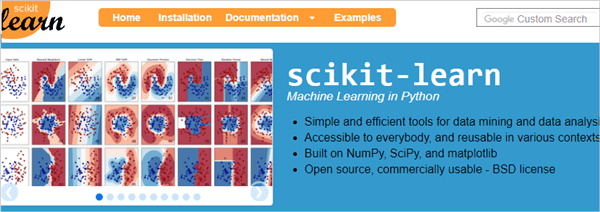
Scikit-learn is for machine learning development in python. It provides a library for the Python programming language.
Features:
- It helps in data mining and data analysis.
- It provides models and algorithms for Classification, Regression, Clustering, Dimensional reduction, Model selection, and Pre-processing.
Pros:
- Easily understandable documentation is provided.
- Parameters for any specific algorithm can be changed while calling objects.
2)PyTorch
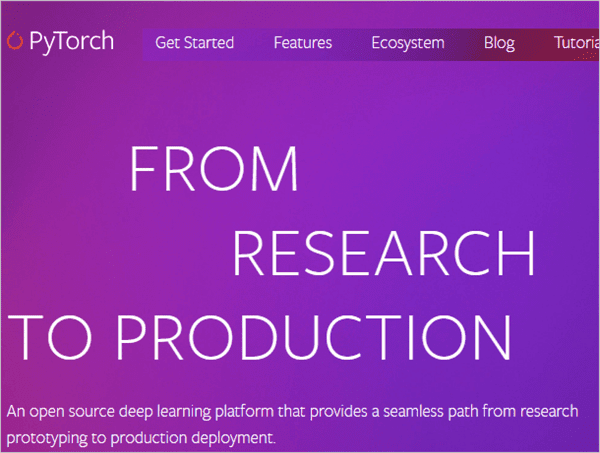
PyTorch is a Torch based, Python machine learning library. The torch is a Lua based computing framework, scripting language, and machine learning library.
Features:
- It helps in building neural networks through Autograd Module.
- It provides a variety of optimization algorithms for building neural networks.
- PyTorch can be used on cloud platforms.
- It provides distributed training, various tools, and libraries.
Pros:
- It helps in creating computational graphs.
- Ease of use because of the hybrid front-end.
3)TensorFlow

TensorFlow provides a JavaScript library which helps in machine learning. APIs will help you to build and train the models.
Features:
- Helps in training and building your models.
- You can run your existing models with the help of TensorFlow.js which is a model converter.
- It helps in the neural network.
Pros:
- You can use it in two ways, i.e. by script tags or by installing through NPM.
- It can even help for human pose estimation.
Cons:
- It is difficult to learn.
4)Weka

These machine learning algorithms help in data mining.
Features:
- Data preparation
- Classification
- Regression
- Clustering
- Visualization and
- Association rules mining.
Pros:
- Provides online courses for training.
- Easy to understand algorithms.
- It is good for students as well.
Cons:
- Not much documentation and online support are available.
5)KNIME

KNIME is a tool for data analytics, reporting and integration platform. Using the data pipelining concept, it combines different components for machine learning and data mining.
Features:
- It can integrate the code of programming languages like C, C++, R, Python, Java, JavaScript etc.
- It can be used for business intelligence, financial data analysis, and CRM.
Pros:
- It can work as a SAS alternative.
- It is easy to deploy and install.
- Easy to learn.
Cons:
- Difficult to build complicated models.
- Limited visualization and exporting capabilities.
6)Colab

Google Colab is a cloud service which supports Python. It will help you in building the machine learning applications using the libraries of PyTorch, Keras, TensorFlow, and OpenCV
Features:
- It helps in machine learning education.
- Assists in machine learning research.
Pros:
- You can use it from your google drive.
7)Apache Mahout
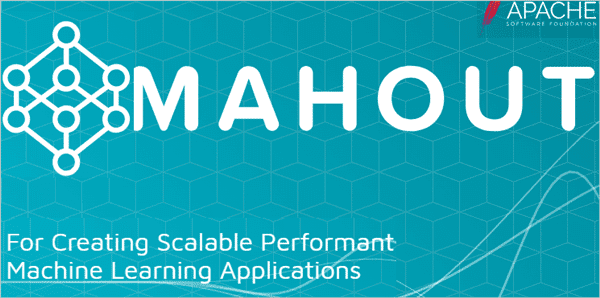
Apache Mahout helps mathematicians, statisticians, and data scientists for executing their algorithms.
Features:
- It provides algorithms for Pre-processors, Regression, Clustering, Recommenders, and Distributed Linear Algebra.
- Java libraries are included for common math operations.
- It follows Distributed linear algebra framework.
Pros:
- It works for large data sets.
- Simple
- Extensible
Cons:
- Needs more helpful documentation.
- Some algorithms are missing.
8)Accord.Net
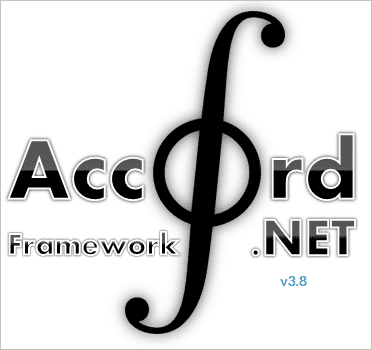
Accord.Net provides machine learning libraries for image and audio processing.
Features:
It provides algorithms for:
- Numerical linear algebra.
- Numerical optimization
- Statistics
- Artificial Neural networks.
- Image, audio, & signal processing.
- It also provides support for graph plotting & visualization libraries.
Pros:
- Libraries are made available from the source code and also through executable installer & NuGet package manager.
Cons:
- It supports only. Net supported languages.
9)Shogun
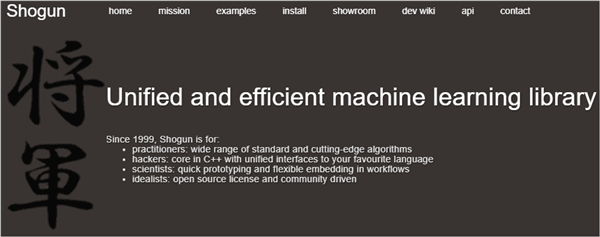
Shogun provides various algorithms and data structures for machine learning. These machine learning libraries are used for research and education.
Features:
- It provides support vector machines for regression and classification.
- It helps in implementing Hidden Markov models.
- It offers support for many languages like – Python, Octave, R, Ruby, Java, Scala, and Lua.
Pros:
- It can process large data-sets.
- Easy to use.
- Provides good customer support.
- Offers good features and functionalities.
10)Keras.io
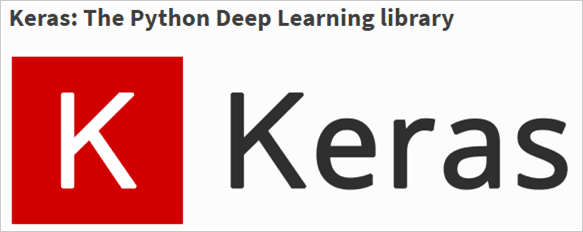
Keras is an API for neural networks. It helps in doing quick research and is written in Python.
Features:
- It can be used for easy and fast prototyping.
- It supports convolution networks.
- It assists recurrent networks.
- It supports a combination of two networks.
- It can be run on the CPU and GPU.
Pros:
- User-friendly
- Modular
- Extensible
Cons:
- In order to use Keras, you must need TensorFlow, Theano, or CNTK.
11)Rapid Miner

Rapid Miner provides a platform for machine learning, deep learning, data preparation, text mining, and predictive analytics. It can be used for research, education and application development.
Features:
- Through GUI, it helps in designing and implementing analytical workflows.
- It helps with data preparation.
- Result Visualization.
- Model validation and optimization.
Pros:
- Extensible through plugins.
- Easy to use.
- No programming skills are required.
Cons:
- The tool is costly.
Tool Cost/Plan Details:
It has four plans:
- Free plan
- Small: $2500 per year.
- Medium: $5000 per year.
- Large: $10000 per year.
Conclusion
In this article, we have explored machine learning and the top machine learning software in detail.
Selection of the tool depends on your requirement for the algorithm, your expertise level, and the price of the tool. Machine learning library should be easy to use.
Most of these libraries are free except Rapid Miner. TensorFlow is more popular in machine learning, but it has a learning curve. Scikit-learn and PyTorch are also popular tools for machine learning and both support Python programming language. Keras.io and TensorFlow are good for neural networks.
Are you looking training with Right Jobs?
Contact Us- Machine Learning Tutorial
- Machine Learning Interview Questions and Answers
- Top Machine Learning Algorithms You Need to Know
- Top AI and Machine Learning Trends for 2020
- The Rise of Artificial Intelligence and Machine Learning Job Trends
Related Articles
Popular Courses
- Artificial Intelligence Training
11025 Learners - Data Science Course Training
12022 Learners - Python Online Training
11141 Learners
- What is Dimension Reduction? | Know the techniques
- Difference between Data Lake vs Data Warehouse: A Complete Guide For Beginners with Best Practices
- What is Dimension Reduction? | Know the techniques
- What does the Yield keyword do and How to use Yield in python ? [ OverView ]
- Agile Sprint Planning | Everything You Need to Know


